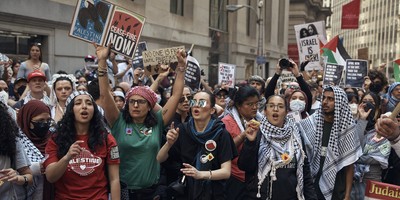The Washington Post ran an article Friday claiming that a recent image Beyoncé released of herself dressed as the Virgin Mary holding her newborn infants was a “re-appropriation of Virgin Mary iconography” which “offers a biting critique of this supreme exemplar of feminine whiteness and the ideology that constructs and perpetuates it.”
It is odd to see Virgin Mary iconography being referred to as the “supreme exemplar of feminine whiteness.” The truth is that throughout the history of the Catholic Church depictions of the Virgin Mary and her many apparitions are a beautiful example of the church’s diversity.
As a Latinx, Catholic woman, my first experience of Mary as a child was admiring the image of La Virgen de Guadalupe. It's a beautiful, Church-recognized instance in December of 1531 of Mary appearing to St. Juan Diego as a half-Spanish, half-Aztec girl clothed in a starry garment. The story goes that Mary performed a miracle by arranging roses in Juan’s tilma to show the bishop. When he unfurled the cloak full of roses a lovely image had been painted of Mary, as a beautiful, mixed-race woman, on the tilma.
The miraculous image helped convert Mexico to Catholicism and is venerated to this day at the Basilica of Our Lady of Guadalupe in Mexico City. Pope Leo XIII officially recognized the image in 1895. Among her titles, she is recognized as “Patroness of the Americas.”
This centuries-old image that is central to the Mexican Catholic experience pre-dates Beyonce’s “biting critique” of the Church’s “whiteness.”
“Beyoncé simultaneously dislodges ‘white’ from its central place in religious iconography and Trump from his recent monopoly of press headlines,” Katie Edwards, the Director of Interdisciplinary Biblical Studies at Sheffield University, goes on to claim.
“The Virgin Mary is traditionally represented in art as a white woman,” she argues. “Often her complexion takes the palest possible hue, apparently connoting holiness and innocence. Cultural critic Richard Dyer showed that ‘in Western representation, whites are overwhelmingly and disproportionately predominant, have the central and elaborated roles, and above all are placed as the norm, the ordinary, the standard. Whites are everywhere in representation.’”
Recommended
Edwards may be correct that there are many images of Mary, especially in Western art, as a white woman, but any practicing Catholic will tell you that there is a rich Catholic recognition of diverse depictions of Mary venerated by all different cultures.
Take for example the 1980 Marian apparitions in Rwanda, recognized by the local bishop, where Mary appeared as "Nyina wa Jambo" or “Mother of the World” to a group of schoolchildren. Her skin was described by the visionaries as “neither black nor white” but “between the two.” She is beautifully depicted in Rwanda at the shrine of Our Lady of Sorrows, where Pope Francis visited in 2014.
There are also many famous depictions of Our Lady of La Vang, an appearance of Mary in traditional Vietnamese garb, to the Vietnamese Christians who were being persecuted and killed and were hiding in the rainforest of La Vang. She comforted them and told them to boil leaves for medicine. In 1820, a chapel was built in her honor. The late Pope John Paul II publicly recognized the importance of Our Lady of La Vang in 1999.
In Poland, the beloved image of the Black Madonna of Czestochowa resides in Jasna Góra Monastery. Tradition has it that the image was painted by St. Luke and was taken to Constantinople then Poland. The image has numerous miracles attributed to it, including saving the monastery of Jasna Góra in a Siege in the winter of 1655. The Black Madonna is officially recognized as the Queen and Protector of Poland.
The image is said to have dark pigmentation because of the smoke from votive candles, however, “Black Madonnas” or depictions of Mary with dark skin have been popular within the Church for centuries.
If iconography of the Virgin Mary really was a “supreme exemplar of feminine whiteness and the ideology that constructs and perpetuates it” it is doubtful that the Black Madonna would be so honored and beloved in Poland.
Beyonce’s artsy depiction of herself as the Mother of God is not so much a biting critique of the Church’s whiteness as an appropriation of a much-loved religious icon. One wonders how the Washington Post would’ve reacted if Beyonce had dressed in a burka or traditional Indian attire, but apparently cultural appropriation is okay as long as it’s appropriation of a Christian symbol.
























Join the conversation as a VIP Member